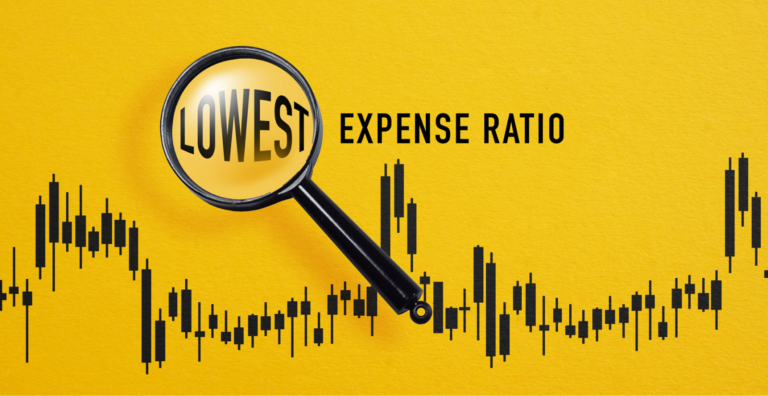
Table of Content
We all want the best mutual fund, but no one wants to pay a fortune in fees to get there. That’s where the lowest expense ratio mutual funds come into play. If you’re hunting for low cost mutual funds that don’t eat into your returns, you’ve landed on the right blog. Today, we’re diving into the details of the mutual fund expense ratio list, what expense ratios even mean, and how they can quietly affect your long-term wealth.
Think of an expense ratio like a subscription fee, but for your mutual fund. It’s the percentage of your investment that the fund house charges you every year for managing your money. For example, if a fund has an expense ratio of 1%, and you’ve invested ₹1,00,000, you’ll pay ₹1,000 annually, whether or not the fund makes money.
Here’s a quick snapshot:
| Component | What it Covers |
| Fund Management Fees | Charges for professional fund management |
| Administrative Costs | Paperwork, record keeping, etc. |
| Distribution Charges | Costs for promoting and distributing the fund |
So, the lower the expense ratio, the more money stays in your pocket. That’s why the lowest expense ratio mutual funds are such a big deal for savvy investors.
You might be thinking, does 0.5% really make a difference? The short answer is yes. Over the years, even a tiny reduction in costs can compound into a big chunk of your returns.
Here’s why going for low cost mutual funds is a smart move:
To prove this, check out this example:
| Investment Value | Fund A (1.5% ER) | Fund B (0.5% ER) | Difference in 10 Years |
| ₹10,00,000 | ₹18,64,388 | ₹19,53,180 | ₹88,792 |
Assuming a 10% annual return before expenses.
There are some sneaky charges not included in the official “expense ratio” label. Knowing these helps you make smarter decisions. Here’s a list of what might fly under the radar:
So, while picking from a mutual fund expense ratio list, always look at the total cost of ownership.
If you’re ready to jump into the lowest expense ratio mutual funds, here’s your 4-step plan:
Check out lists online or use reputable platforms that show detailed fund data.
Direct plans usually have lower expense ratios than regular plans (since no agent commission is involved).
Funds like Nifty 50 or Sensex index funds often come with super-low expense ratios.
Even low cost mutual funds need regular tracking. Expenses may change.
Taxes on your mutual fund gains depend on two things: the type of fund and how long you hold it. Here’s a quick guide:
| Fund Type | Holding Period | Tax Rate (2025) | Tax-Free Limit |
| Equity Mutual Funds | <12 months (STCG) | 20% | None |
| ≥12 months (LTCG) | 12.5% above ₹1.25 lakh | ₹1.25 lakh | |
| Debt Mutual Funds | <36 months (STCG) | Your income tax slab | None |
| ≥36 months (LTCG) | 12.5% | None |
One thing that is clear from the above illustration is that lower expense ratio means lower costs and higher returns. Even a 1% difference in costs can make a big difference to the eventual corpus. How can you consciously lower your expense ratio. Here are 3 ways.
Writing in his now famous letter to shareholders in 2016, Warren Buffett richly appreciated lauded the role played by Sir John Bogle, founder of Vanguard Funds in creating wealth. According, to Buffett, Bogle had shown that it was possible to create massive wealth by just managing the expense ratios. Is it not surprising coming from a top quality stock picker and active investor like Buffett. Here is the wisdom in the argument.
Vanguard has been a passive investor in the sense it never gets into stock selection. Vanguard funds are based on the belief that it is hard to beat the market and much harder to select funds that beat the market. Hence Vanguard just focuses on investing in good indices which can give solid equity returns with minimal risk and very low costs. As said earlier, index funds don’t need to manage money actively, so costs are lower. According to a study on index funds, Vanguard alone had saved over $600 billion for mutual fund investors since its inception.
Every rupee you save in fees is a rupee that gets to grow for you. By investing in the lowest expense ratio mutual funds, you’re not only cutting down on costs but also unlocking the power of smart, long-term investing. You don’t need to be a finance guru. Just choose wisely, compare your options, and track your investments. It’s all about keeping more of what you earn.
Now that you know how to spot the lowest expense ratio mutual funds, it’s time to put that knowledge to work. Don’t let hidden costs eat away at your wealth. Choose smart. Stay invested.
Anything below 0.5% for index funds or below 1% for actively managed funds is generally considered low.
Not always, but mostly yes. Direct plans avoid distributor fees, so they often have better returns over time.
Yes. Fund houses can revise the expense ratio based on performance, AUM, or other internal changes. Always review periodically.
No. Look at past performance, fund manager, portfolio quality, and your own investment goal. The expense ratio is just one (important) factor.
![]() IIFL Customer Care Number
IIFL Customer Care Number
(Gold/NCD/NBFC/Insurance/NPS)
1860-267-3000 / 7039-050-000
![]() IIFL Capital Services Support WhatsApp Number
IIFL Capital Services Support WhatsApp Number
+91 9892691696
IIFL Capital Services Limited - Stock Broker SEBI Regn. No: INZ000164132, PMS SEBI Regn. No: INP000002213,IA SEBI Regn. No: INA000000623, SEBI RA Regn. No: INH000000248, DP SEBI Reg. No. IN-DP-185-2016, BSE Enlistment Number (RA): 5016
ARN NO : 47791 (AMFI Registered Mutual Fund Distributor), PFRDA Reg. No. PoP 20092018

This Certificate Demonstrates That IIFL As An Organization Has Defined And Put In Place Best-Practice Information Security Processes.